|
|

Television tower, Shanghai |
|
China is a land of mythical mysteries that remain entangled in the pages of its five thousand years old history. This largest East Asian nation offers a mystic landscape as vivid as the Huang Ho River, places that connote a rich heritage from time unknown, handicrafts that suggest patience and finesse, people who touch your heart with warmth and food that pleases the palate. China takes away the major portion of the Asian continent and Republic covers seven per cent of the world's land area. However, it is important to understand the peripheries of different titles and address attached to the country while gauging its land area and population. China is officially regarded as People's Republic of China (PRC) that includes the mainland China, two Special Administrative Regions of Hong Kong and Macau and disputed claims over Taiwan. Republic of China (ROC) is composed of the island groups of Taiwan, the Pescadores, Kinmen, and Matsu that is in loggerheads with PRC on authority over Taiwan. After the announcement of ‘One-China Policy’ in the 1970s by the more economically significant and diplomatic PRC, ROC nearly lost ts global recognition. Today, Beijing, formerly Peking is the capital of China and Shanghai is the country’s largest and most prosperous city. Other important port cities are Wuhan, Tianjin, Shenyang, Guangzhou, Harbin and Dalian (Canton).
China boasts of one of the most ancient and recorded civilisation of the world. From the centuries reign by different dynasties, internal turmoil to Communist agendas and rule, China has developed by leaps and bounds in every sector. Presently, it is regarded as one of the super powers of the world and is a major global determinant with high-end technology, strong defence support and eloquent foreign ties. Human resource is another advantage of China and currently, it is the most populous nation in the world. The people of china are the best example of multi-ethnicity, which is comprised of 56 different communities. Among these, the Han Chinese ethnicity makes up about 92% of the population and is divided into several subgroups with strong cultural similarities. Though Chinese language is dominated by numerous local dialects, the Mandarin being the most prominent, the Beijing dialect or Putonghua is regarded as the official language of the entire country. As for religion, different Chinese sects practice Taoism, Buddhism, and Chinese folk religion in temples. Confucianism is often taken up as an intellectual pursuit. Beliefs like Yin and Yang, Feng Shui, ancestor worship and shamanism are also prevalent in China and are part of the great Chinese philosophy and culture.
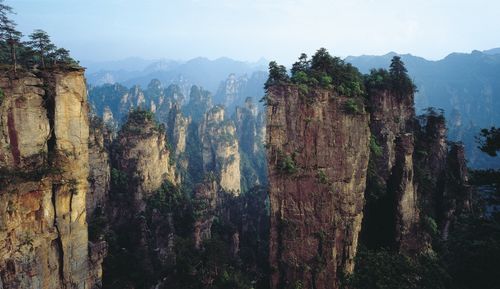 Zhangjiajie National Forest Park
Zhangjiajie National Forest Park
|
Geography
China, taking into accounts the calculation of PRC, is spread over an area of 3,691,502 sq miles (9,561,000 sq km) and the population head count crosses 1,306,313,812. The country has a vast 18,000-kilometer coastline along the Yellow Sea, the East China Sea, Korea Bay and the South China Sea. The land borders of China are bounded on the east by Russia and North Korea, on the north by Russia and Mongolia, on the west by Tajikistan, Kyrgyzstan, Kazakhstan, Pakistan, and Afghanistan, and on the south by India, Nepal, Bhutan, Myanmar, Laos, and Vietnam.
The topography of China is abundant with nearly all elements of nature including hilly regions, plateaus, seashores, river basins and lowlands. Though, it is the mountain ranges of western and southwestern China that cover nearly forty percent of the total landscape. Its principal ranges are the Tien Shan, the Kunlun chain, and the Trans-Himalaya. The highest point of Mount Everest is also situated in this region. The Tibetan plateau along with the more arid landscape of deserts such as the Taklamakan and the Gobi Desert is located on the northern and north western frontiers. The alluvial plains along the eastern coastlines and the central plain of Manchuria are home to the major part of the Chinese population. Near to these terrains is situated the fertile deltas of the China's two major rivers, the Huang Ho and Yangtze River (Chang Jiang). Other major rivers include the Xijiang River, Mekong, Brahmaputra and Amur. China also has many lakes and wetlands. The country terrain is prone to several natural hazards like dust storm of Gobi desert, the infamous floods of Yellow river, tsunamis, earthquakes and droughts.
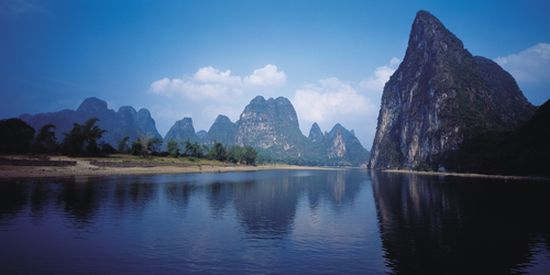 Li river (Li Jiang)
Li river (Li Jiang)
|
Climate
The sprawling topography of China plays a big role in its contrasting climatic conditions. While the northern terrains chill under the sub arctic weather with Siberian influence, the southern half steams under typical tropical climate. The summers are hot and humid here with abundant rainfalls. The monsoon winds go errant in China due to its difference in latitude and altitude in separate regions. From September and October to March and April next year monsoon blow from Siberia and the Mongolia Plateau into China and decrease in force as it goes southward. It causes dry and cold winter in the country and a temperature difference of 40 degree centigrade between the north and south. Monsoon also blows into China from the ocean in summer, bringing with them warm and wet currents, thus rain. Great differences in climate are found from region to region owing to China's extensive territory and complex topography. If the western mountain ranges of the Himalaya remain snow-capped all year round with no summer, the northern arid tabletops and deserts lack a single drop of rain.
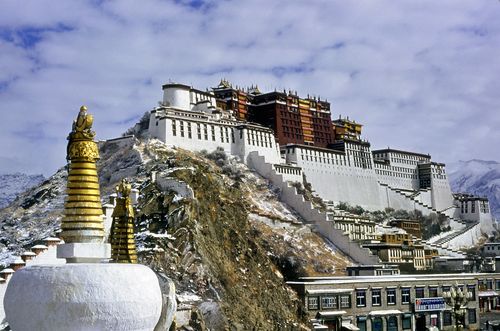 Potala Palace in Lhasa Tibet
Potala Palace in Lhasa Tibet
|
History
China has been the breeding ground of an advanced civilisation that rivalled the sophistication and richness of any society found in Europe, the Middle East, or the Americas at that time. The stone tools and fossils of Homo erectus found in north and central China are the earliest evidences of human existence in the region. Thousands of years later the modern Homo sapiens inhabited the region of present-day China and from this time on the country prospered uninterruptedly. It became a thriving region with usage of calendar, writing, the wheel, silk, gunpowder, astronomy and mathematics. China has been the den of imperial rules and it witnessed emergence, expansion and destruction of innumerable dynasties from time to time. The first recorded historic timeline appears from the Shang Dynasty in perhaps the 13th century BC. The Zhou Dynasty produced the influential philosophers like Confucius, Mencius and Lao Tse who swept the region with intellectual movements.
 The Great Wall of China
The Great Wall of China
|
The Qin dynasty was the first ruling family that managed to unite China as a single Legalist state under one Emperor. The first stone of the Great Wall was embedded at this time. The succeeding Han Dynasty lasted four hundred years and brought in one of the most culturally enriched age of China. It opened up the Silk Route, the famous trade path to India and Europe and embraced Buddhism. Tang dynasty prospered on the basis of this religious belief. The thirteenth century saw the arrival of Genghis Khan to China. His grandson Kublai Khan, one of the most celebrated emperors, established the Yuan Dynasty. Marco Polo, the famous adventurer and merchant, spent many years in China around this time. During the Ming Dynasty, China concentrated inwards and large-scale domestic developments took place. Today's version of the Great Wall was constructed in this period and the palace, later known as The Forbidden City was built at Beijing. During the mid seventeenth century, the Manchus, invading from the north, founded the Qing dynasty ruling China until the beginning of the twentieth century. Foreign trade was not welcome in China but the Portuguese settled in Macao and in the eighteenth century, the East India Company established trade in Canton. Following the Opium War of 1839, China lost Hong Kong to Britain.
Political unrest and dissatisfaction within Chinese people led to civil wars and rebellions and in 1911 Sun Yat-Sen became the president of China's first provisional government, the Republic of China. However, it was short lived as the Chinese Communist Party was founded in 1921 and a power struggle appeared between the Nationalists and the Communists. The war between China and Japan came to a halt after the later was defeated at the end of the Second World War. Subsequently, on 1 October 1949 Mao Tse-tung declared the formation of the People's Republic of China. This became the sole legal government of China. In the mean time, the Korean War and border clashes with India along Tibet took place. During the Cultural Revolution of the sixties of the twentieth century, Chinese society opened up to foreign relations. Chairman Mao died in 1976 and Deng Xiaoping became Party Chairman. Hong Kong reverted to Chinese sovereignty in July 1997 and Macao returned to China in 1999. But power tussle over Taiwan and several outlying islands of Fujian continues between PRC and ROC.
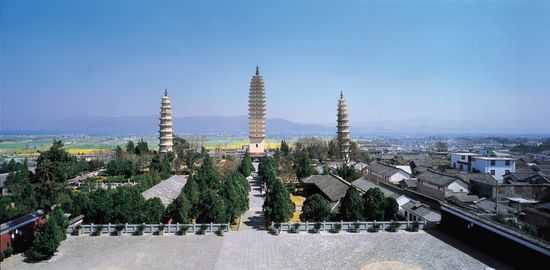 Dali San Ta Si (Three Pagodas)
Dali San Ta Si (Three Pagodas)
|
Economy
China is one of the financial super powers in the world with a potential to send ripple through world market with its every move. Under the Communist regime it started out as a centrally planned, closed market and socialist economy. But subsequent rulers realised the need of foreign trade and controlled but free market to become a significant global fiscal entity. In this bid, the "Great Leap Forward" of 1958-60 was not successful in its aim to increase industrial production. However, during the Cultural Revolution in 1971 with President Nixon's visit to China, the country began a new relationship with the outside world.
Abundant non-unionised inexpensive labour, wide variety of small-scale enterprises, huge natural resources and increased foreign trade and investment resulted in quadrupling of GDP since 1978. Measured on a purchasing power parity (PPP) basis, China in 2004 stood as the second-largest economy in the world. Today the People's Republic of China is one of the world's fastest growing economies. Economic ties between China and Taiwan have increased over the last ten years with Taiwan, one of China's main sources of imports. Unequal distribution of income, unemployment, low per capita income and stringent state holding are the stumbling blocks to the Chinese economy.
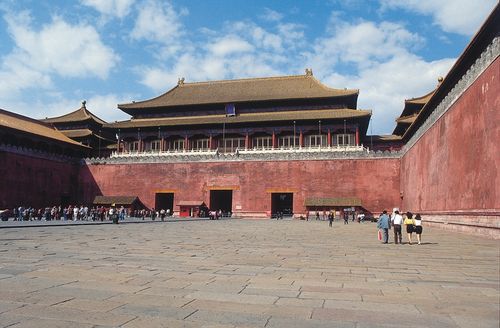 Beijing, The Forbidden City
Beijing, The Forbidden City
|
Politics
The republican influence in the political set up of china is evident from its formal address of People’s Republic of China. In reality, China is a one-party state that adheres to a strange mix of democratic rights in a socialist framework. The real power lays with the Chinese Communist party, which has reformed its stand heavily following foreign interaction, the infamous protests of Tianamen Square and opening up of the economy. Though, censorship of political speech is routine, the system functions under separate sections of executive, judiciary and legislative with the support of the 1982 constitution. The unicameral legislature is the National People's Congress (NPC), consisting of 2,985 deputies elected to terms of five years. They are elected by municipal, regional, and provincial people's congresses of China. It normally follows the directives of the Communist party's politbureau and supervises the conduct of the government.
The executive branch comprises of a premier, who is head of the government, and a president, who is the head of state. The cabinet is known as the State Council and the members are appointed by the National People's Congress. The judiciary consists of the Supreme People's Court, Local Peoples Courts and Special Peoples Courts. However, the judges are appointed by the National People's Congress. The overall rule in China has a tinge of autocracy, as any organised opposition against the Communist Party is not tolerated.
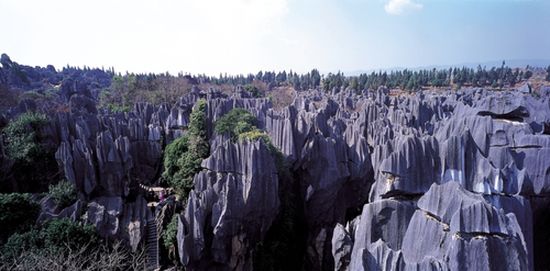 The Stone Forest near Shillin
The Stone Forest near Shillin
|
|
|

